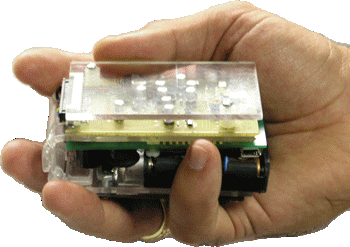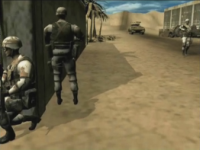|
What is Ancile?
 Ancile is a prototypical information system that warns dismounted soldiers of incoming indirect fire
attacks while reporting their location to existing command and control systems. The main component of
this system is a pager-like device worn by the individual soldier. This device periodically transmits
the location of the soldier and listens for threat warnings. When a threat warning is received, the
pager sounds an audible or vibratory alarm that increases in frequency as the threat approaches.
Depending on the type of ammunition and its trajectory, soldiers may have a few seconds to well over
a minute to improve their protective posture before enemy rounds detonate near them.
Ancile is a prototypical information system that warns dismounted soldiers of incoming indirect fire
attacks while reporting their location to existing command and control systems. The main component of
this system is a pager-like device worn by the individual soldier. This device periodically transmits
the location of the soldier and listens for threat warnings. When a threat warning is received, the
pager sounds an audible or vibratory alarm that increases in frequency as the threat approaches.
Depending on the type of ammunition and its trajectory, soldiers may have a few seconds to well over
a minute to improve their protective posture before enemy rounds detonate near them.
The prototype we built consists of two types of devices: an end device that is carried by the
soldier, and a bridge device that is mounted on a vehicle or at an operations center. The end device
looks like a slightly oversized pager and runs on standard AAA batteries.
Check out the video!
Click on the image and watch (or download) a 2-minute video that shows Ancile at work. (File is in WMV format and is 17 MB in size.) |
 |

Does it actually work?
Yes. Field testing was performed during a live mortar fire event at Yuma Proving Ground, Arizona
in April of 2005. The basic premise of the test was that if the Ancile system was connected to the
warning systems on a local area network (LAN), the pagers should generate alarms correctly. Since
Ancile is designed to operate with no user intervention, the test was conducted likewise. All
system inputs came from the network interfaces. The only interaction with the system
components was in setting them up for the test and in collecting data between trials.
In a series of tests, the Ancile pagers were correctly stimulated by the sensor systems with no
required changes to the later beyond providing them the internet protocol (IP) address of the Ancile
bridge. In all cases but one, rounds launched at the northern impact area triggered the pager that
was configured with static coordinates that placed it in that area. Similarly, rounds launched at
the southern impact area triggered an alarm on the south pager. After detecting many mortar rounds,
the only instance of a round not triggering an alarm occurred when pager erroneously calculated the
POI as being 50 meters further away from the pager than it actually was. After examining the code,
we found that a simplifying assumption in the algorithm that calculates the distance between the pager
and the POI was to blame. We independently calculated the error introduced by this assumption as almost
exactly 50 meters at the latitude and longitude of the test site.
|

